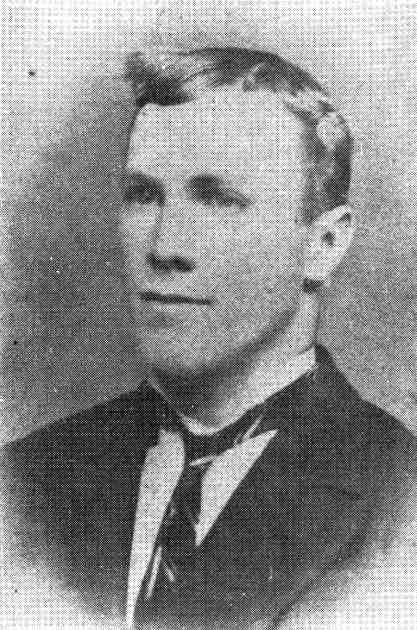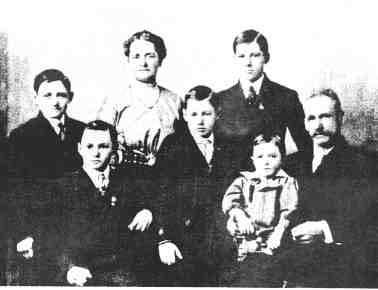


(sb8famly.jpg) The Samuel 8 Bigelow Family 1910
(Left to Right)
Horace, Gideon, Cassie, Ted, Potter, Oscar, Samuel
Samuel 8 BIGELOW was born
29 Nov 1860 in Canning, Nova Scotia the ninth of ten children. His father
Ebenezer and two older brothers, John F. and Gideon were ship builders.
An older brother Joseph died in May 1860 age six and a sister Julie died
in June 1860 age one, both in the year of Sam's birth. As far as we know
Sam was born in the "Bigelow" house on the corner of North Ave. and Bigelow
St, in Canning, Nova Scotia.
In 1861 Canning established free schooling through
general assessment of the people. For many years the teacher lived from
house to house, his sojourn varying from three to five days to as many weeks,
according to the number of pupils that the various homes sent him. This
system had the advantage of bringing the teacher into closer contact with
the pupils and parents. School books in those times were not numerous, and
it was not uncommon for a single book to include the whole course of a child's
study. Eventually a school was built.
In 1876 there were two school terms a year. The
"Big Summer" term ended in September. The teacher's salary for the term
was $50. The winter term ended in April and the teacher's salary was $60.
A boy was paid $6 to make the fires during the
winter. By this time Sam was 16 and probably out of school.
For amusement during that time people had get
- togethers such as singing around an organ, quilting and sewing bees, taffy
pulls, skating parties, sleigh rides, marble games and dancing. They were
also used to walking for miles at one time.
Folks usually slept on straw ticks, under feather
puffs. One of the most hated jobs on a farm was picking sheep's wool. The
men who liked cider often bought rum barrels for their cider making. In
the fall men banked their homes with earth, sawdust or
trees to keep out drafts.
There are numerous accounts in "Old Timers-Canning
and Habitant" that the Bigelows were house builders as well as ship
builders, so it is here that Sam learned his trade as a reputable carpenter.
I can only speculate why Sam didn't become a recognized
ship-builder although he probably assisted his father and brothers
when he was young. By the time Sam was 16 it was 1876 and many British
Merchants were now turning to steam, so the
demand for Canadian built sailing vessels was much less than in the past.
Even though Canadian ownership of wooden sailing
vessels was greater than ever before by the mid 1880's the wooden square-rigged
sailing ship was rapidly becoming obsolete.
It was being replaced by the steel steamship, a more efficient and reliable
method of transportation. So it was obvious that there
was no future for a young man of 20 in ship building.
According to Armour, "By the 1890's many of the
builders and owners were old men, and few of the younger men were willing
to continue the businesses. while the wooden sailing ship could be built
with little over head, a great deal of capital was needed to establish and
outfit a yard for building steel vessels. Although steel vessels could carry
large cargoes. They were more expensive to buy and required more capital to
operate. The great profits of the earlier years were no longer to be made
and most businesses preferred to put their money into more lucrative ventures.
"
On July 31, 1881 Sam's father, Ebenezer, divided
his property among his children as best he could. His memoirs indicate that
he worried because his name was retained in the ship building company "E.
Bigelow, Sons & Co." His eldest son John E. was the senior or Managing
director. Sam was now 20 years old and took to farming the original Bigelow
homestead.
Canning is located in the Annapolis Valley of
Nova Scotia, bread basket of the Maritimes. The modern Canning owes its
existence largely to the potato industry created by a disease in 1844 of
New England potatoes. The productivity of the area
also made the valley one of the most progressive fruit-raising sections
of the whole American continent.
Article continued on Page 2
Back to Samuel (8) Page :

